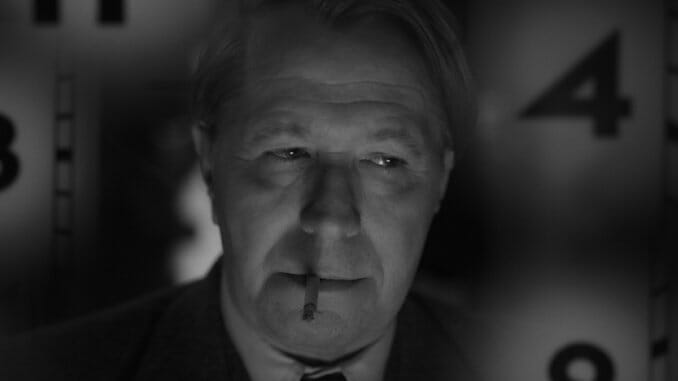Mank Is a Beautiful, Uneven Cinematic Rant from David Fincher
Photos Courtesy of Netflix
To talk about screenwriter Herman J. Mankiewicz is to talk about Citizen Kane, which is to say it’s to talk about power, money, fulfillment, and success. And if you’re director David Fincher, to make a movie about Mankiewicz is to make a movie like Citizen Kane. A would-be insider epic held up by reference-heavy repartee and painted with all the aesthetics of the revolutionary movie, really this is a movie for Fincher to flex his film history—an earlier, more serious Hail, Caesar! with Orson Welles in the laurels and Mankiewicz on the cross. Netflix’s Mank might not nearly live up to its subject’s crowning achievement, but it’s still a dense and enjoyable cinematic rant that would make its central lout proud.
At first, much of the film seems to rest on Gary Oldman’s performance as Mank, the rapscallion whose wit, writing, and refusal to stay sober ingratiated him with and infuriated so many. Possessing the standard writer’s one-two combo of alcoholism and self-loathing, Mank heads towards social and physical self-destruction. Thankfully—since Oldman’s creaky groan and wobble don’t belie much warmth, and his one-liners needed another draft before drawing the kind of (even mean-spirited) adoration the movie tells us they do—the movie quickly becomes the story of the shifting industry and political climate around ‘30s Hollywood during Mank’s time conceptualizing, then writing Citizen Kane. This is where the power and money of Kane collide. Ironically, scenes focused on Mank, especially in the present when he’s actually dictating the first draft of Kane, are easily the worst part of Mank.
Those propping him up (sometimes literally as the lush partakes) include MGM boss Louis B. Mayer (Arliss Howard), studio exec Irving Thalberg (Ferdinand Kingsley), Mank’s brother Joe (Tom Pelphrey), and actress Marion Davies (Amanda Seyfried). All bow to newspaper baron William Randolph Hearst (Charles Dance), eventual inspiration for Kane.
Dance is one of the great features of the film (particularly how the imposing statue enunciates “Nazis”), giving the film a pair of its most striking walk-and-talk sequences alongside one from Howard down a studio hallway that’s all balls and brass. These two and Seyfried are bliss compared to Oldman and Tom Burke’s Welles, who’s less a character or an impression in this film than a sort of off-screen elemental idea. A looming, Satanical force—and this was supposed to be the draft that’s nice to Welles. Seyfried in particular crafts charming, sad, and sweet layers to an actress that’s pseudo-carefree gait, humor, and sensitivity bears the baggage of a career and life that’s been bought and paid for.
And she’s not the only thing. While her gilt prison is hammered home via lazy mid-party stroll through Hearst’s San Simeon and its in-house zoo, another large portion of the film is the 1934 California gubernatorial race. Frank Merriam beat Upton Sinclair (Bill Nye, here as The Socialist Guy) thanks in part to an MGM-backed smear campaign. The politics ground the film, which threatens to become so masturbatorially industry-centric as to chafe.
-

-

-

-

-

-

-

-

-

-

-

-

-

-

-

-

-

-

-

-

-

-

-

-

-

-

-

-

-

-

-

-

-

-

-

-

-

-

-

-








































